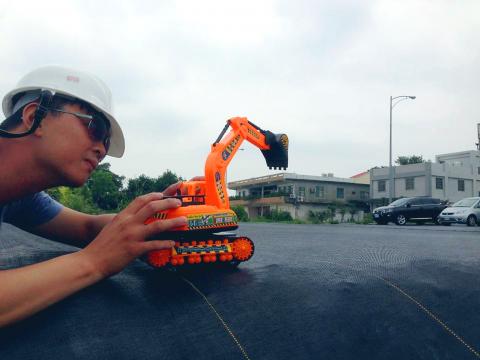|
Miaoli officials
urged to respect Hakka culture
EDUCATIONAL: Critics of a plan to use a
Chinese-style building for a Miaoli tourist center said officials could visit
local villages to study indigenous architecture
By Loa Iok-sin / Staff reporter

An Internet user using the
nickname Kuso, unhappy about the recent demolition of four households in Miaoli
County’s Dapu Borough, pretends to tear down the home of Miaoli County
Commissioner Liu Cheng-hung in this picture taken from Facebook yesterday.
Photo courtesy of Chien Hung-wei
Democratic Progressive Party Legislator Wu
Yi-chen (吳宜臻), along with several Hakka activists, yesterday urged the Miaoli
County Government to halt a project to build a tourist information center
outside the planned high-speed rail station in Houlong Township (後龍), saying
that its chosen architectural style has no cultural connection to Hakkas living
in Miaoli.
In order to leave an impression of Hakka culture on travelers arriving at the
station, the county government plans to build a tourist information center in
front of the station in the tulou style (土樓) — a traditional fortress-like
communal residence found in mountainous regions in the southern parts of China’s
Fujian Province.
While tulou architecture is not uniquely Hakka, the architectural style is
considered Hakka by many, since most remaining tulou are found in Hakka
villages.
However, for Hakkas in Taiwan, the architectural style is as foreign as it is to
many non-Hakkas.
“Chinese tulou have no cultural or historical connection to Taiwanese Hakkas, [a
tulou in Miaoli] is like something that fell from the sky — it doesn’t belong to
Taiwan or Miaoli,” Ceng Nian-you [曾年有], a Miaoli-based Hakka culture and history
researcher, told a press conference at the Legislative Yuan in Taipei yesterday.
“We have our own culture in Miaoli, why is the county government not using local
cultural elements for the tourist information center?”
He said that for local Hakkas, the traditional residential building is a huofang
(夥房) — literally “communal house” in Hakka — which has a square layout, with a
courtyard in the middle for agricultural activities such as sun-drying rice or
vegetables, or for banquets, and a hall for religious use.
“I don’t understand why the county government had to tear down century-old kilns
that once stood on the site of the high-speed rail development, and replace them
with something that has no local connection,” Ceng added.
Chern Ban (陳板), a visiting professor at National Taiwan University of Arts and a
Hakka from Miaoli, said that there are no tulou buildings in Taiwan due to its
unique society and culture, and there is no need to build one now.
“Tulou in Fujian were built for security reasons, and when Hakkas moved to
Taiwan, they didn’t feel the need to build any, because, on one hand, they
didn’t feel threatened, and on the other hand, the humid climate and frequent
earthquakes do not suit earth buildings,” Chern said.
Ayu Huang (黃連煜), a Hakka musician from Miaoli, said that while all Hakkas may
share something in common, each Hakka community has unique elements.
“Hakkas in Fujian build tulou, but most of the Hakkas in Miaoli trace their
ancestry to China’s Guangdong Province, so tulou are not only unfamiliar to us,
but also would have been to our ancestors,” he said. “As a musician, I would be
concerned if the Miaoli County Government imported traditional Hakka music from
China and called it local music.”
Wu added that if Miaoli County Commissioner Liu Cheng-hung (劉政鴻), who has come
under severe criticism over his handling of controversial demolitions in Dapu
Borough (大埔) last week, cares enough about Hakka culture, he should read
research by the Hakka Affairs Council. This found that there are no tulou in
Taiwan, and confirmed that the most representative Hakka architecture in Taiwan
is the huofang.
“If he doesn’t know what a huofang looks like, he should go to Hakka villages in
the county and he would easily spot some,” Wu said.
|
![]()
![]()
![]()